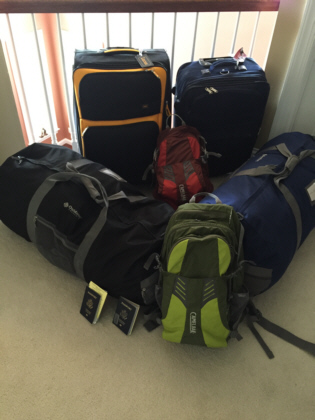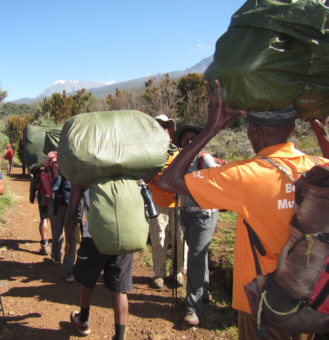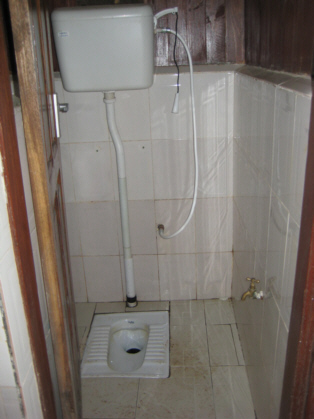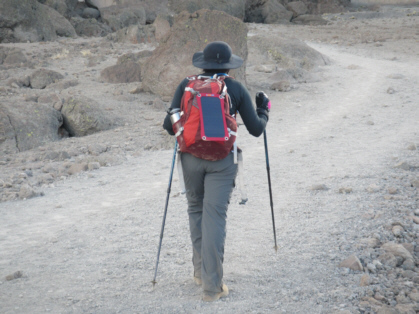
Preparing For Our African Adventure
Traveling to Africa from the U.S. is not as simple as pack your bags and go - especially if you have never been there or if it has been a long time since your last visit. There are a number of time-consuming tasks that need to be completed before your trip. In the two months leading up to our trip, preparing for Africa seemed to be the main topic of conversation between Traci and me. Therefore, I recommend doing research to construct your checklist at least three months in advance and begin executing the checklist at least two months in advance if possible. On this page, I will discuss the tasks we had to complete before traveling to Tanzania and Ethiopia. I have also included a Preparing to Climb Mt. Kilimanjaro section in which I discuss the lessons learned and special preparations in regards to climbing the mountain.
Preparing For Tanzania and Ethiopia
- Passport: Our passports were already current but if you need to get one or renew yours, I recommend starting the process a few months in advance because you will need to use it to get visas. The usa.gov/passport website has details on obtaining a passport. Get a few extra passport photos because you might need them for your visa application.
- Visas: Give yourself a few weeks for this step - especially if you are obtaining a visa through the mail. We needed to get visas for entry into Tanzania and Ethiopia (because Traci and I were doing a sightseeing stopover). Visit the embassy website for the country you are visiting to find out their requirements for obtaining a visa. Since we live just outside of Washington, D.C., Traci was able to leave work for a few hours to submit our applications at the appropriate embassy and return to pick up our visas. The Tanzania embassy had a morning time range for dropping off your application materials which included your passport and payment among other things. You needed to return in the afternoon to pick up your visa. This prevented her from getting our Ethiopia visas and Tanzania visas on the same day. Fortunately, Marie Frances, the trip organizer, was able to meet Traci for lunch in D.C. while Traci was waiting to pick up our visas. This was a pleasant way to pass the time. For Ethiopia, there was a long line just to drop off our application materials. Traci had to return several days later to pick up our visas. Finally, there is a possibility that you can purchase your visa when you arrive at the airport of the country you are visiting. Some people said they had to wait hours to do this. Others were able to make it through the process in as little as 15 minutes. You should check with the country's embassy to find out if purchasing a visa on arrival is an option. Then it is up to you to determine if you want to take the chance on a visa purchase when you arrive in the country.
- Immunizations/Vaccinations: Refer to the country's embassy website to find out if you need to show proof of immunizations to enter the country. It is also helpful to look up the country on the U.S. State Department web site. To get the required/recommended immunizations, my primary care provider referred us to a travel medicine clinic. We were able to get our shots there and prescriptions for medicine such as malaria pills, cipro, and altitude sickness (because we were climbing Mt. Kilimanjaro). If you work for a company that has its own medical clinic, you might be able to get your immunizations there. I was able to get most of my immunizations at work for free. For our trip, we got shots for yellow fever, hepatitis A, typhoid, and a Tdap (Tetanus, diphtheria and pertussis) booster.
- Money: Tanzania and Ethiopia are mainly cash societies. In other words, do not count on being able to easily use your credit card, debit card, or ATM card. Plan to use cash. Tanzania will accept U.S. dollars. We did not need to convert to Tanzanian shillings. Your notes should be new and in good condition. Make sure that some of the cash you bring is in small denominations, i.e., singles and 5's. This will help with small purchases and tips for bellmen. Since the Tanzanian portion of our trip was a package, all of our meals were included. We did not need money for food. However, we needed a significant amount of cash for Mt. Kilimanjaro gratuities and the safari guide gratuities. For the Mt. Kilimanjaro climb Traci and I gave a total gratuity of $700 to our support team. For the 5-day safari, Traci and I gave a total of $150 to our driver. In Ethiopia, we converted $100 to the local currency (Birr). Between a dinner, souvenirs, and tour guide/driver tips, we spent all our birrs during our two-day visit. Finally, you should let your credit card company know your travel plans in case you do have the opportunity to use your card while you are abroad. Otherwise, your transaction might be declined as 'suspicious' if a purchase in Africa does not fit your normal spending pattern.
- Travel Insurance: I highly recommend purchasing travel insurance. You never know when something like flight delays, lost luggage, illness, or some other mishap can derail your travel plans. Travel insurance can help you get some or all of your money back in those cases. I shopped around online for our travel insurance and found out the prices for policies vary greatly. For us, it was important that we had medical evacuation coverage since this would be climbing Mt. Kilimanjaro. A medical evacuation could cost you tens of thousands of dollars out-of-pocket without coverage. We ended up using the travel insurance company recommended by my credit card company. They had the best price for the coverage we wanted. Shop around.
- Clothing: For our trip, we brought casual sightseeing clothes - short-sleeves, long pants, and light jacket. I tried to bring clothing that I would not need to iron. We brought shorts but did not wear them. Although the temperature was mild during the day, it dropped off to light jacket/long-sleeve weather in the evening. Our itinerary did not call for any dress-up clothing so we did not bring any. We needed to bring winter and hiking clothes for Mt. Kilimanjaro (see Preparing for Mt. Kilimanjaro). It is important to know in which season the country you are visiting will be. Our Africa trip took place in late June/early July. Since Tanzania is below the equator, its seasons are opposite of North America. Tanzania was in its winter. However, since the country is near the equator we experienced temperatures in the 70's and upper 60's Fahrenheit. Furthermore, it was Tanzania's dry season. We did not experience any rain while we were there. On the other hand, Ethiopia is above the equator and was in its rainy season. Fortunately, we did not get rained on while we were there. The temperatures were in the 70's and upper 60's Fahrenheit.
- Electricity: You will need an electricity converter. For convenience, I recommend bringing a multi-receptacle cord to plug into your converter. It will allow you to charge more than one device at a time.
- Flashlight: Make sure you have a flashlight or some other battery-powered lighting source because you never know when there will be a power outage. We experienced a brief one in Moshi and in Karatu. The safari lodge we stayed at on the Serengeti only provided electricity during certain times of the day. I always had my headlamp in my pocket or in my daypack while in Africa.
- Duct Tape: I am so glad that Traci suggested I bring this. Two of our bags were ripped by the airline. We filed claims with the airline but this can take months to be resolved. Our immediate fix was to use the duct tape to patch the tears. I will always travel with duct tape from now on.
- Mobile/Internet: Feel free to bring your mobile devices. Check with your mobile carrier to find out about their international plan. You can buy a SIM card for your phone in Africa. Traci and I did not use our mobile phones on this trip. Instead, we used Wi-Fi to send emails. Internet and Wi-Fi were available at all the hotels we used. Most places charged a fee for Wi-Fi or use of their business center internet. The connections in Tanzania were often slow and inconsistent. The connection in our hotel in Ethiopia was fast, reliable, and free.
- Safari: If you plan to do a safari in Tanzania during the dry season, consider bringing a hat, jacket, and dust mask. You will be riding on dirt roads for hours that will have you and the entire interior of the safari vehicle covered in a layer of reddish-brown dirt. Bring insect repellent containing DEET. Otherwise, the black flies will annoy you to no end. Check with your travel medicine clinic to see if you need to take malaria prevention pills. Traci and I needed to take them two days before, during, and a week after our trip.
Preparing to Climb Mt. Kilimanjaro
We climbed Mt. Kilimanjaro via the Marangu Route (6-day itinerary). Purchasing gear for the climb is not cheap - especially if you are like Traci and me who did not own any hiking or camping gear before this trip. You should peruse the gear checklist as soon as book your climb so that online shopping can be one of your options. This could save you money. We used the Kilimanjaro Gear Packing List as our guideline on what to purchase. Even though we did not always buy high-end items, we still spent several hundred dollars. We were able to cut the cost by buying items at Walmart or on Amazon.com instead of at sporting goods stores or specialty outdoor recreation stores. All of the equipment and clothing we bought worked fine for our trek. In this section, I provide my notes about some of the items on the checklist.
- General: Refer to Preparing for Tanzania and Ethiopia.
- Duffle Bag: A water-proof duffle bag that is large enough to hold a sleeping bag and clothing can be expensive. I was able to find an inexpensive one in Walmart. The label did not claim that the bag was waterproof. It only claimed to protect gear. The exterior was cloth but the interior was lined-with tarp-like vinyl. To be safe, I treated the exterior with Scotch Guard. When we arrived at the mountain, I found out that the porters put our duffle bags in a waterproof tarp before carrying them.

porters covered our gear in tarp before carrying them

